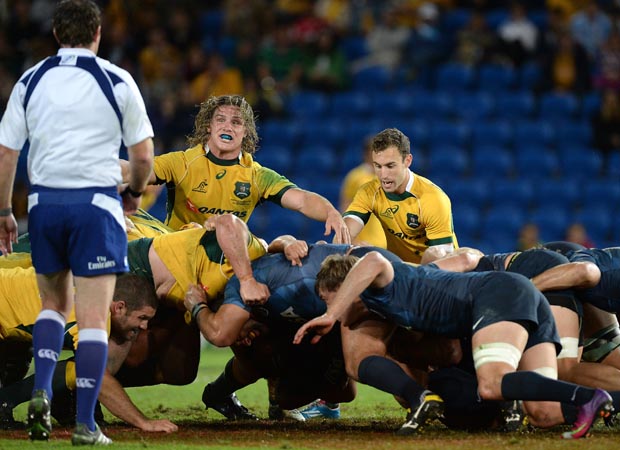 Here we are just two weeks into the season and already my old front row partner Brian Moore is banging on about the scrum. His overzealous focus on the new engagement, plus the way that teams are trying to anticipate the referee's call to engage to hit early and gain an advantage, is totally misjudged.
Here we are just two weeks into the season and already my old front row partner Brian Moore is banging on about the scrum. His overzealous focus on the new engagement, plus the way that teams are trying to anticipate the referee's call to engage to hit early and gain an advantage, is totally misjudged.
Brian and the various teams employing the tactic seem to think that going early will give them an advantage as they will be on the front foot and potentially have stolen a couple of inches, putting the opposition under pressure.
Brian seems to think that these few inches are the thin end of the wedge and that slowly referees will allow the game to go back to a form of engagement that allows for a hit-and-drive plus a crooked feed.
I understand where his concerns and fears emanate from, but in order for that to happen it would need referees to once again abdicate responsibility for the engagement of the scrum which, although they are still not enforcing the straight feed consistently, is something that is unlikely to happen.
The fact is an early hit can actually be a major disadvantage to a team depending on whether or not the referee enforces the mark and the fact that the scrum must be stationary before the ball is presented.
If a team engages early and moves forward over the mark and the referee makes them move back to the mark without resetting, any advantage they had achieved by engaging fractionally early would be lost and would, in fact, become a benefit for the opposition.
A stationary scrum before the ball is introduced also mitigates against any advantage of a slightly early hit, as it enables the opposition the time to regain balance and, should it be necessary, to change foot position to enable them to either lock or drive the scrum.
Too much emphasis is now being placed on the engagement with free kicks being awarded if a team go fractionally early whereas in previous times the engagement wasn't an issue and referees just enforced the mark and the stationary scrum laws.
It was one of the first rules (Laws) you learned as a schoolboy forward and were constantly reminded by teachers and referees when scrums were formed with the instruction issued: “No pushing before the ball comes in.”
All the new variations and attempts at cleaning up the scrum have happened only because the referees allowed the ball to be put into a moving scrum or at an angle.
The dangerous act of charging into a scrum was an attempt by one team to drive the opposition scrum backwards as the ball was fed (usually crookedly) into the scrum to ensure possession while moving forward.
If referees had continued to enforce the stationary scrum law and moved the offending team back to the mark before the ball was allowed to be presented, it is likely that charging and the subsequent variant of the ‘hit' would have quickly vanished from the game as a ball-winning tactic, although it may have remained for ‘macho' reasons.
It is the simplest of tactics to allow an aggressive prop the advantage at the engagement and move backward so that the referee either penalises him for pushing early or makes him back-up to the mark, disrupting his scrum.
The new sequence has done away with charging but still allows for an aggressive hit, albeit at short range, but that in itself should have no bearing on the outcome of the scrum, whether early or not, as the engagement is just one step in a sequence of preparing for when the ball is put in.
First your scrum comes together and binds in whatever way suits you. I preferred my arm under the loosehead's (Jason Leonard) on the opposition's put-in but we reversed it for our ball so I helped lock his bind on the hooker (Brian Moore).
When the rest of the pack was formed the referee would call engage and both packs came together remembering the old rule: “No pushing till the ball comes in.”
We either positioned our feet and body angle to lock the scrum while supporting Brian if he was striking for our ball, or prepared for a concerted push as the ball was fed on the opposition's put-in with a timed call.
There were a variety of calls and pressure moves for how we wanted the scrum to move and for disrupting the opposition ball after it was hooked, but none of those calls had anything to do with the engagement.
Many of what I would call ‘bad practices' have come into the game from the Southern Hemisphere where the scrum does not hold the respect that it engenders here in Europe.
The Australians have struggled to produce front rows of suitable international quality and have been responsible for many of the various forms of engagement and quick crooked feeds in order to compensate for their lack of proficiency in this area.
Although they have succeeded in persuading the IRB to change the way the scrum is refereed, recent articles by former Wallaby captain Nick Farr-Jones and Enrique (Topo) Rodriguez in the New Zealand Herald point out it is still an ongoing problem mainly because of a lack of coaching and development in that area.
While we in Europe have good front row players, if we want a game where the scrums are stable and not continually being penalised or reset, the referees must go back to refereeing the mark and the straight feed and forget about the engagement.
*This article was first published in The Rugby Paper on September 14.




























Pingback: citas adultos málaga